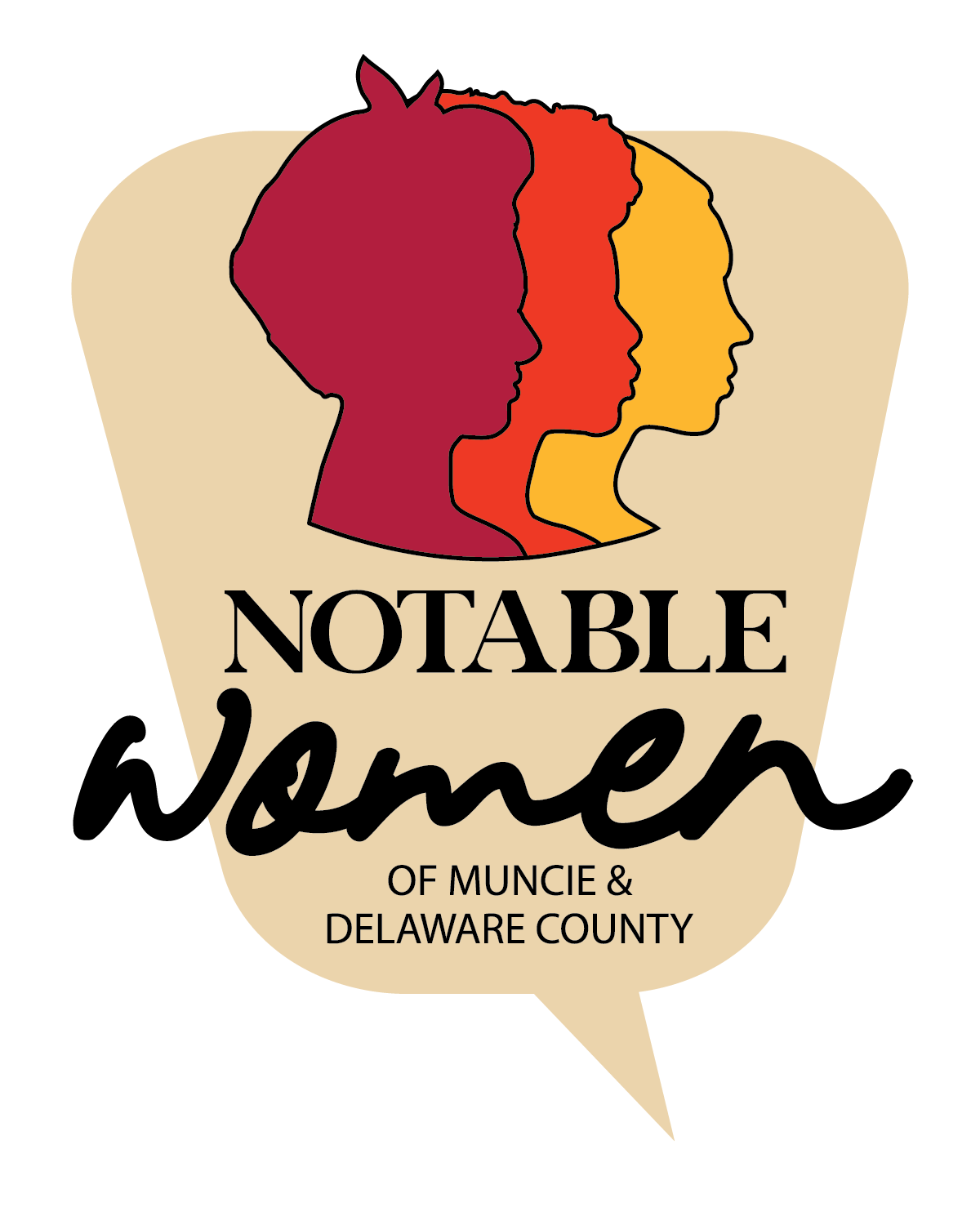Browse Exhibits (6 total)
Town on Fire 2020
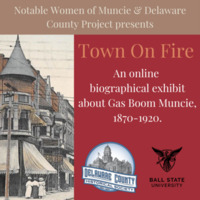
Welcome to Town on Fire, an exploration of Hoosier and Muncie women’s history during the Gilded Age and Progressive Eras (1870-1900 and 1900-1929 CE). This project was made in collaboration with the Delaware County Historical Society in Muncie, Indiana; the Ball State University History Department; the Ball State University Libraries; and the Notable Women of Muncie and Delaware County Project.
This exhibition explores Gas Boom Muncie (1870-1920 CE) from the perspectives of six women-citizens. Their lives offer a window into the history of this Midwestern American city, when women's labor and civic roles were rapidly expanding due to industrialization and urban reform movements. Too often individual women and their perspectives are underappreciated in modern historical research. Yet these women show how the Progressive Era's diverse groups lived side-by-side: different races and religions, socio-economic and familial statuses, and politics and value systems. The view they offer us of turn-of-the-century Muncie is complex, but its value is found in that complexity.
Feel free to move through the exhibition in order or explore at your own pace.
Click “Introduction” to begin.
Banner Image Caption: Muncie, Indiana: 1884, 1884.



Town On Fire 2021
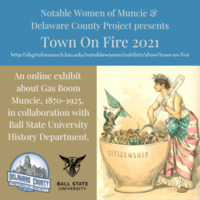
Welcome to Town On Fire 2021, an exploration of Hoosier and Muncie women’s history during the Gilded Age and Progressive Eras (1870-1900 and 1900-1929 CE).
In Fall 2020, students from Ball State University's Department of History celebrated the centennial anniversary of the 19th Amendment (1920) to the American Constitution by investigating the lives of six women who lived during the long campaign for woman suffrage. Working in teams, students from HIST 200-02 Introduction to History and Historical Methods created six short documentary videos. Archival sources provided indications of their life events and scholarly secondary sources contextualized those experiences amid the country's great changes. The results were surprising and exciting, leading to conference presentations and a second exhibit.
This year the Town On Fire exhibit returns to Gas Boom Muncie and its aftermath (1870-1920 CE) to investigate six working women. Their biographies highlight the different types of work that women participated in, from physically demanding labor to elite cultural skills and socially impactful leadership roles. With the discovery of natural gas in the late 1880s and the construction of many new factories in the 1890s, Muncie's population grew and diversified. The six women profiled in this second exhibit reveal the city's increasing racial, religious, and class differences. Where Robert and Helen Lynd, the authors of Middletown: A Study in American Culture (1929), described a relatively homogenous small city, this exhibit sees evidence of prosperity that did not require uniformity. Muncie's long history of active women and varied work environments reminds us that strength is found in difference.
Feel free to move through the exhibition in order or explore at your own pace.
Click “Introduction” to begin.
This project was made in collaboration with the Delaware County Historical Society in Muncie, Indiana; the Ball State University History Department; the Ball State University Libraries; and the Notable Women of Muncie and Delaware County Project.
Banner Image Caption: Logo by Lacey Back Lantz, Notable Women of Muncie and Delaware County (2021).



Town On Fire Fall 2022
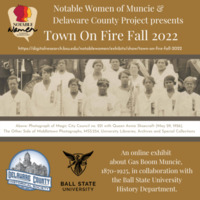
Welcome to Town On Fire Fall 2022, an exploration of Hoosier and Muncie women’s history during the Gilded Age and Progressive Eras (1870-1900 and 1900-1929 CE).
In Fall 2020, students from Ball State University's Department of History celebrated the centennial anniversary of the 19th Amendment (1920) to the American Constitution by investigating the lives of six women who lived during the long campaign for woman suffrage. Working in teams, students from HIST 200-02 Introduction to History and Historical Methods created six short documentary videos. Archival sources provided indications of their life events and scholarly secondary sources contextualized those experiences amid the country's great changes. The results were surprising and exciting, leading to conference presentations and more exhibits.
In Fall 2022 students investigated the impact of gender, race, and class on the lives of five more Hoosier women. As the new videos show, these themes impacted women’s employment, education, public reputation, and freedom. With the expansion of the railways in the 1870s, the discovery of natural gas in the late 1880s and the construction of many new factories in the 1890s, Muncie's population grew and women found new opportunities to work outside the home, develop social networks, and apply their education and skills in empowering ways. Class often determined education, which could expand or limit a woman’s wealth and opportunities. Gender norms were both implicit and explicit in this time period. A woman’s contribution to her family business, and social or religious community might have been essential, but that did not mean she appeared in its records. Race also complicates matters, through segregation and the application of racial stereotypes.
Interest in these themes leads directly to related historical lenses. Historians uncover the past by applying historical lenses that prompt important questions. Students using a gender lens might ask whether women tend to work in a few specific industries and men in other industries? Or how was a woman’s work visible or invisible in business records? Students using a racial lens might ask whether (and how) newspapers describe people from different racial groups. Or did newspapers, census records, and city directories show members of the same race clustered together? Students using a class lens might ask how social activities identify working class or professional class members? Or how did a woman’s class appear in ways that are different from a man’s class?
In the following five exhibit pages, we hope you’ll think about how gender, race, and class combined at a time of great change. As our student-historians follow the best historical practice, think about the questions that you would like to ask about life in Gas Boom Muncie and its aftermath (1870-1920 CE). Also, what questions do you have about the historian’s process? These biography videos show transparent investigations of five women’s lives, and the methodology videos reveal the challenges and achievements of investigating the past. We hope that you will join us on the journey and learn from our work.
Feel free to move through the exhibition in order or explore at your own pace.
Click “Introduction” to begin.
This project was made in collaboration with the Delaware County Historical Society in Muncie, Indiana; the Ball State University History Department; the Ball State University Libraries; and the Notable Women of Muncie and Delaware County Project.
Banner Image Caption: Logo by Lacey Back Lantz, Notable Women of Muncie and Delaware County (2021).



Town On Fire Fall 2023
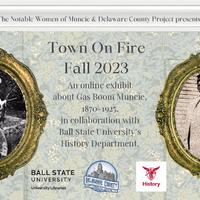
Welcome to Town On Fire Fall 2023, an exploration of Hoosier and Muncie women’s history during the Gilded Age and Progressive Eras (1870-1900 and 1900-1929 CE).
This is the sixth and final installment of the Town On Fire exhibits, curated by Dr. DeSilva. In Fall 2020, students from Ball State University's Department of History celebrated the centennial anniversary of the 19th Amendment (1920) to the American Constitution by investigating the lives of six women who lived during the long campaign for woman suffrage. Since then, working in teams, students from HIST 200 Introduction to History and Historical Methods have created short historical documentaries about women's lives. These videos have been based on original archival research and contextualized with scholarly secondary sources. This project has shown that undergraduate students can be historians from start to finish.
This final exhibit returns to important themes: women's work, civic lives, migration, and criminal arrests. As in life, some women have left ample documentary trails, while others seem to have disappeared. In the following exhibit pages, think about the big ideas that run through this project: gender, class, and race. Then and now, we are impacted by these characteristics in intersectional ways.
Feel free to move through the exhibition in order or explore at your own pace.
Click “Introduction” to begin.
This project was made in collaboration with the Delaware County Historical Society in Muncie, Indiana; the Ball State University History Department; the Ball State University Libraries; and the Notable Women of Muncie and Delaware County Project.
Banner Image Caption: Logo by Lacey Back Lantz, Notable Women of Muncie and Delaware County (2021).



Town On Fire Spring 2022
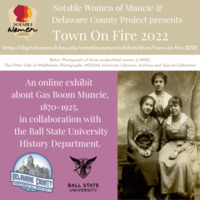
Welcome to Town On Fire 2022, an exploration of Hoosier and Muncie women’s history during the Gilded Age and Progressive Eras (1870-1900 and 1900-1929 CE).
In Fall 2020, students from Ball State University's Department of History celebrated the centennial anniversary of the 19th Amendment (1920) to the American Constitution by investigating the lives of six women who lived during the long campaign for woman suffrage. Working in teams, students from HIST 200-02 Introduction to History and Historical Methods created six short documentary videos. Archival sources provided indications of their life events and scholarly secondary sources contextualized those experiences amid the country's great changes. The results were surprising and exciting, leading to conference presentations and a second and third exhibit.
In Spring 2022 the Town On Fire exhibit returns to Gas Boom Muncie and its aftermath (1870-1920 CE) to investigate six women who grappled with the pressures of race and gender expectations. While Muncie was not officially segregated, the contemporary expectation that white women and black women lived in different cultural worlds resulted in social segregation, the criminalization of bi-racial marriage, and many lost opportunities for female solidarity. The six biography videos highlight how women encountered similar pressures to conform to feminine models of family- and community-focused caregivers in the period before they were voting citizens. Sometimes the social and economic pressure that women faced was too much and they buckled. At other times their achievements inspired their neighbors to join their initiatives.
With the discovery of natural gas in the late 1880s and the construction of many new factories in the 1890s, Muncie's population grew and women found new opportunities to work outside the home, develop social networks, and apply their education and skills in impactful and empowering ways. These biographies reminds us of the truth of Josephine St. Pierre Ruffin's words: "We are justified in believing that the success of this movement for equality of the sexes means more progress towards equality of the races." Taken together we can see how race, class, and gender layered women's experiences, prompt intersectional discussions, and complicate our understanding of local and national expansion.
Feel free to move through the exhibition in order or explore at your own pace.
Click “Introduction” to begin.
This project was made in collaboration with the Delaware County Historical Society in Muncie, Indiana; the Ball State University History Department; the Ball State University Libraries; and the Notable Women of Muncie and Delaware County Project.
Banner Image Caption: Logo by Lacey Back Lantz, Notable Women of Muncie and Delaware County (2021).



Town On Fire Spring 2023
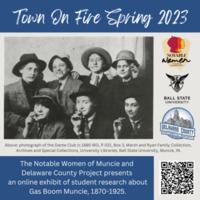
Welcome to Town On Fire Spring 2023, an exploration of Hoosier and Muncie women’s history during the Gilded Age and Progressive Eras (1870-1900 and 1900-1929 CE).
Town On Fire is a collection of student-made videos that combine historical investigation and reflection. This series of biographical exhibits grew out of the Delaware County Historical Society's desire to uncover previously passed over women's history. The project began in Fall 2020, in conjunction with the centennial anniversary of the 19th Amendment (1920) to the American Constitution, and has proven to be historically challenging and personally surprising.
Working in teams, students from HIST 200-01 Introduction to History and Historical Methods have created six new short documentary videos to add to the previous twenty-three videos (2020-2022). All these videos grow out of archival sources that are contextualized using scholarly secondary sources. By creating these videos, students practice foundation historical skills and create new knowledge.
In Spring 2023 student teams took on new challenges. Traditionally, each team researchs one woman and begins with a name. This semester two teams investigated groups of women whose names are so far unknown. Muncie's Black female glass workers are remembered by an often reproduced photograph. Lenape women are part of the larger lost indigenous community that is known from generalized monuments. Another woman is known only from her migrant son's draft card. These women joined Edith Love, Ida Rickman, and Mattie McGuire as Spring 2023's Notable Women.
Change is the central theme in this semester's research. None of these women lived in Muncie their entire lives. One woman, Donatila Lizarraga, never set foot in the city. Other women were only memories. Some women migrated here for work and school, while others left for the same reasons. All of these women sought social and economic stability at a time when travel across the continent was easier than ever. Migrating from Kentucky, Ohio, or Mexico, and to Indianapolis, New York, and Chicago shows that women were just as willing to migrate and eager to work as men were. Geographic and professional change is central to this semester's notable women, yet some things stayed the same.
Feel free to move through the exhibition in order or explore at your own pace.
Click “Introduction” to begin.
This project was made in collaboration with the Delaware County Historical Society in Muncie, Indiana; the Ball State University History Department; the Ball State University Libraries; and the Notable Women of Muncie and Delaware County Project.
Banner Image Caption: Logo by Lacey Back Lantz, Notable Women of Muncie and Delaware County (2021).



